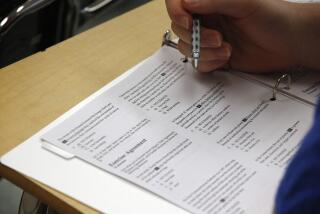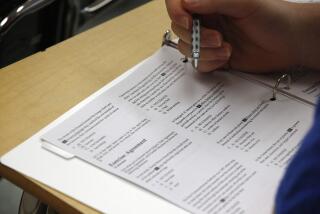The New SAT Won’t Test Students’ Sanity
- Share via
Since 1941, American high school students have participated in the unpleasant ritual of taking the SAT. In March 2005, the Educational Testing Service will introduce the most radical changes to the test it has ever made. Even the perfect score is increasing, from 1600 to 2400 (so parents should start multiplying their own scores by 1.5 so as not to embarrass themselves when their kids ask, “What’d you get on the SAT?”). Teenagers and their parents are panicked. Our advice, as experienced test prep coaches: Don’t worry.
Why is ETS making these changes? It says it’s to “improve the alignment of the test with current curriculum and institutional practices,” which would make sense if high schools had just recently started teaching writing and colleges recently started requiring writing.
There’s a much more likely explanation: ETS is caving in to pressure from a number of groups, including the University of California, whose former president said that without these changes the UC system would no longer require the SAT as an entrance requirement. Faced with the loss of their biggest customer, ETS officials did what leaders of any proud institution would do: saluted and got out their No. 2 pencils.
Here are the changes that are in the SAT next spring:
* The verbal section: This section will be just like the old one, minus the annoying analogies (removed to reflect the decreasing role of vocabulary in our school systems) and with the addition of a section of short critical-reading passages. Don’t worry. These changes make the section easier than ever, because the hardest part about prepping kids for the SAT has always been the immense, elephantine, even behemoth task of memorizing lists of vocabulary words.
* The math section: This section will lose the quantitative-comparison section and will be beefed up to include slightly more difficult questions on topics like Algebra II. Don’t worry. Kids generally dislike the quantitative comparisons, and all the newly tested material is already included in the SAT II-Math IC test that most students take now. They’ll simply have to learn it a few weeks earlier.
* A new writing section: This is the section causing the most terror. Students will have to write an essay and answer questions about English grammar and usage. Don’t worry. This material all comes from the SAT II writing test, which is being phased out with the introduction of the new SAT. And the SAT II essay has always been the most coachable part of the test. Let’s face it, no one’s writing anything brilliant in 20 minutes. If you can learn to make it coherent, you will get a decent score.
We in the test prep business have long believed that the ETS is an intensely lazy company. The concept of standardized tests implies regularity and predictability. The cost and time required to truly reinvent the SAT would be incalculable, so instead of reinventing the wheel, ETS simply took a couple of wheels from another of their cars (the SAT II) and stuck them on the back of the SAT.
But there is no need to worry. The changes will only make the test more coachable. There will still be test prep companies, still be the unfair biases inherent in the test and, if the ETS ploy works, still be an undue emphasis on the test when it comes to applying to colleges. So relax: Even though the SAT is changing, as with everything else from ETS, the more things change, the more they stay the same.
Dov Engelberg and Sandy Frank are directors of a test preparation and academic tutoring company in Los Angeles.






